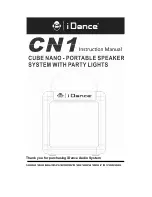
GEN4065 4000 Surge Watts/3250 Running Watts Portable Generator
17
SOME NOTES ABOUT POWER CORDS
Long or thin cords can require more wattage from a generator to power an electrical device. Figure 6 shows the recommended cords according to
the power requirement of the electrical device. When using cords that exceed these specifications, allow for the electrical device to have a slightly
higher rated wattage requirement.
Device Requirements
Max. Cord Length (ft) by Wire Gauge
Amps
Watts (120V)
Watts (240V)
#8 wire #10 wire
#12 wire
#14 wire
#16 wire
2.5 300
600 NR 1000 600 375 250
5
600
1200 NR 500 300 200 125
7.5 900
1800 NR 350 200 125 100
10 1200
2400 NR 250 150 100 50
15 1800 3600 NR
150
100
65 NR
20 2400 4800 175
125
75 50 NR
25 3000 6000 150
100
60 NR
NR
30 3600
7200 125 65 NR NR NR
40 4800
9600 90 NR NR NR NR
NR = Not Recommended.
Figure 6 - Maximum Extension Cord Lengths by Power Requirement
DC Usage
The DC outlet is only for recharging 12 Volt automotive-type batteries. Do not connect any other device to this outlet.
Use this generator only for recharging 12 Volt batteries. NEVER attempt to jumpstart a car with this generator.
Failing to use the correct procedure can cause a battery to explode, seriously injuring anyone nearby. Keep heat, sparks, flame and
smoking materials away from the battery.
To connect 12 Volt batteries to the DC outlet:
1. Connect one charging wire to the positive terminal of the battery and the other charging wire to the negative terminal of the battery.
2. Connect the free end of the positive wire to the positive side of the outlet on this generator.
3. Start this generator.
4. Carefully connect the free end of the negative wire to the negative side of the outlet on this generator.
5. When disconnecting, always disconnect the wires from this generator first to avoid a spark.
Storage batteries emit highly explosive hydrogen gas when charged.
Batteries also contain acid, which can cause severe chemical burns.
• Do not allow open flames or cigarettes nearby for several minutes after charging a battery.
• Always wear protective goggles and rubber gloves when charging a battery.
• If battery acid gets on the skin, flush with water.
• If battery acid gets in the eyes, flush with water and immediately call a physician.
• If battery acid is swallowed, drink large quantities of milk and immediately call a physician.
Do not secure the generator with a chain or rope, which would prevent it from being moved in an emergency.
Meijer.com








































